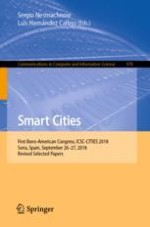2019 | Buch
Smart Cities
First Ibero-American Congress, ICSC-CITIES 2018, Soria, Spain, September 26–27, 2018, Revised Selected Papers
herausgegeben von: Sergio Nesmachnow, Luis Hernández Callejo
Verlag: Springer International Publishing
Buchreihe : Communications in Computer and Information Science
